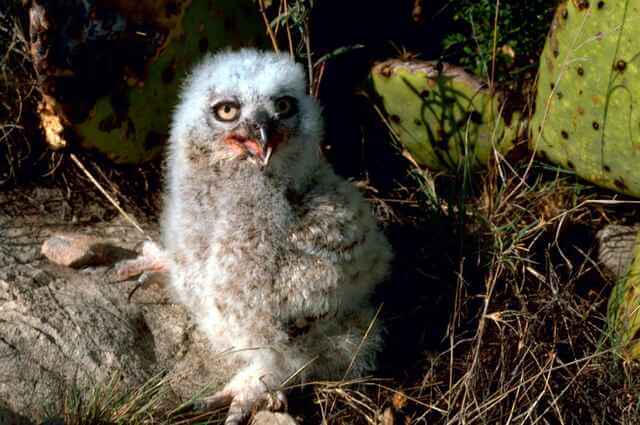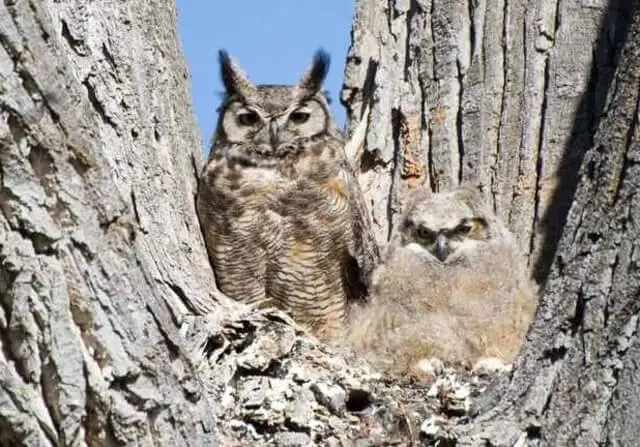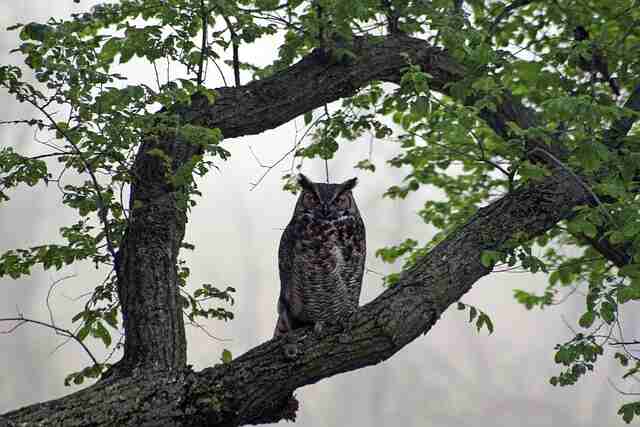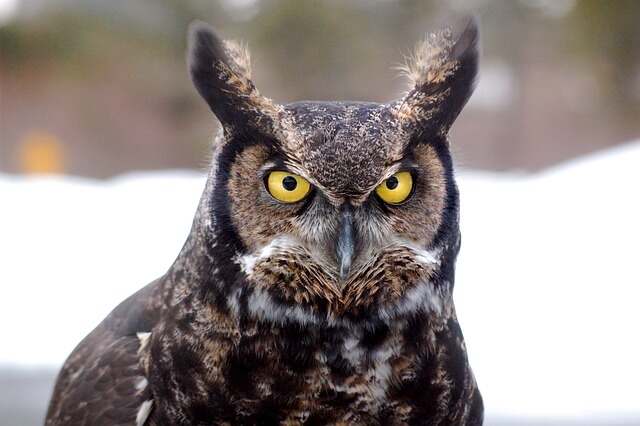Owls have long fascinated humans with their mysterious presence and nocturnal habits. Among the various species, the Great Horned Owl stands out as one of the most captivating. Known for its distinctive ear tufts and piercing yellow eyes, this majestic bird has many intriguing secrets waiting to be discovered. Whether you’re a bird enthusiast or simply curious about wildlife, join us as we delve into 45 Great Horned Owl Facts that are sure to surprise and delight you.
Table of Contents [show]
Great Horned Owl (Overview)

| Identification | Large size, round head, spotted brownish-gray plumage with reddish-brown face and throat (some with white v-shaped throat marking), “horns” above ears, 1.5-inch hooked black beak, large yellow eyes with black pupils. |
|---|---|
| Size | Length: 17.7-25.2 in (45-64 cm), Weight: 32.2-88.2 oz (912-2500 g), Wingspan: 39.4-57.5 in (100-146 cm) |
| Taxonomy | Order: Strigiformes, Family: Strigidae, Genus: Bubo, Scientific Name: Bubo virginianus |
| Range | North America, Central America, South America, and Mexico |
| Habitat | Forests, deserts, mountain ranges, grasslands |
| Diet | Mainly small mammals (rabbits, rodents, skunks, opossums), also includes reptiles, amphibians, birds (up to the size of grouse), and larger prey |
| Population | North American Population: est. 3.9 million individuals, Global Population: est. 6 million (Least Concern – Population stable) |
| Nesting Behavior | Reuses old nests from various birds, lays about four eggs per clutch, female incubates for 30–37 days, male cares for offspring until they leave the nest at about 8 weeks |
| Incubation Length | 29–32 days |
| Nestling Length | 40–42 days |
| Clutch Size | 1–4 eggs |
| Number of Broods | 1 Brood |
Great Horned Owls are found in a variety of habitats.
Great horned owls are found in a variety of habitats, including coniferous and deciduous woodlands, mountainous areas, open country, or even semi-desert scrubland or urban areas. They seem to prefer lowlands that have wooded areas for nesting and perching, as well as a nearby source of water.
Female Great Horned Owls are 20% larger than males
Female Great Horned Owls exhibit a substantial size advantage, typically measuring between 17-22 inches (43.1-55.9 cm) in length and weighing approximately 20% more, ranging from 3.5-5.5 pounds (1.6-2.5 kg). In comparison, males reach sizes of 16-19 inches (40.6-48.3 cm) in length and weigh in the range of 1.5-2.7 pounds (0.7-1.2 kg).
Great Horned Owls typically mate for life.
Great Horned Owls are known for their strong sense of monogamy, forming lifelong bonds with their chosen mate. Once a pair has established this profound connection, it typically endures until the passing of one of the partners, illustrating their unwavering commitment to each other.
Great Horned Owls are generally solitary creatures.
Great horned owls are generally solitary creatures. They hunt by night to catch their prey, either by picking it out of dense vegetation or waiting on a perch for prey to come to them. They are also extremely territorial creatures, meaning that they will not tolerate another great horned owl near their own territory.
Predators of the Great Horned Owls.
The primary predators of Great Horned Owls are other raptors, such as larger owls, like the Great Gray Owl and the Eurasian Eagle Owl. These larger owls can prey upon and compete with the Great Horned Owls for resources.
Additionally, other predators that may pose a threat to Great Horned Owls include coyotes, foxes, raccoons, and larger birds of prey, such as eagles and hawks.
These predators may target the eggs, young, or injured owls. However, it’s important to note that Great Horned Owls are skilled and formidable predators themselves, and they are capable of defending themselves and their nests against potential threats.
They have adaptations that make hunting for food easy.
The great horned owl is a nocturnal creature that uses the darkness of night to avoid predators and hunt for food. Their excellent hearing allows them to pick out prey in the dark.
They have a number of adaptations that make hunting for food easier in the night, including pupils that expand when it’s dark and sensors in their beak, which can pick up small differences in temperature.
They also have ear tufts, which they display when they are agitated or annoyed with their surroundings. These tufts can be erected at anytime, not just when they are upset.
Great Horned Owls are active at night, and rest during the day.
Great horned owls are active at night, and during the day they rest in a tree or on the ground with their wings tucked into their body. When disturbed, the great horned owl will direct their head and neck downwards and look down them and at their feet as they hold this position for about two minutes before returning to a normal resting position.
They will also make a series of soft hooting or screaming sounds as this is what they use to communicate with each other, although their calls usually consist of single, repetitive notes which may include hoots and screeching sounds such as those that they use when warning others of an intruder.
The Great Horned Owl’s preferred diet.
The great horned owl’s diet consists of rodents of small to medium sizes, which includes hamsters, gerbils and rabbits. They also consume some insects and frogs. Their diet may be supplemented by fruit during the winter months, when they are restricted to living in forest areas.
They may also consume small reptiles such as skinks, and snakes occasionally. They will also eat fruits like acorns or chestnuts, which can be found at the tops of trees in winter.
The life expectancy of a Great Horned Owl.
The average life expectancy of a Great Horned Owl in the wild is 13-15 years, while their life expectancy in captivity is between 20 and 30 years. There are a number of factors that contribute to this disparity between their lifespan in captivity and their lifespan in the wild. These include diet, predation from other animals, habitat destruction and injury from larger predators such as coyotes or wolves.
Great Horned Owl newborns are born with their eyes closed.
Great horned owl babies are born with their eyes closed, but open them when they’re about two weeks old. This is just in time for the owlets to start looking out of the nest, but the owls cannot see very well at this point.
They are nearsighted for their first few months in the nest and can only make out large shapes or differences in light intensity. The owl chicks start seeing much better when they are about 8 weeks old.

Newborns are called “Owlets”.
The newborn owls that hatch from the eggs of a Great Horned Owl is called “owlets”. The term pertains to birds who have not yet fledged (laid its first flight feathers). Owlets stay in their nest or on branches with their parents until they learn how to fly and hunt for themselves.
They feed newborns by regurgitating their food.
Great Horned Owls feed their young ones by swallowing whole small animals and then regurgitating the food into their mouths. The mother will pick up the prey with her talons and squeeze it down into the baby’s open mouth. This process of eating may seem unusual, but this strategy is actually quite common among owls.
Great Horned Owls talons have incredible crushing power.
The talons of a Great Horned Owl are incredibly strong. They can exert 300 – 500 PSI of crushing power, which is more than enough to kill small animals like rabbits and mice in one quick swoop! Their sharp claws make it easy for the owl to get a grip on its prey before delivering the death blow.
They have talons that measure 4 to 8 inches.
Great Horned Owls have talons that measure 4 to 8 inches. The purpose of their talons is to hold onto prey and keep it from escaping. Their grip can be so strong, in fact, that they are able to carry animals up to three times their own weight!
They can rotate their heads 270 degrees.
One of the most striking things about owls is their head rotation. What many people don’t know is that these owls can rotate their necks 270 degrees without breaking anything in their neck or spine. This fascinating ability, which lets them see in all directions, also makes it possible for them to eat without moving from where they are perched or sitting.
The secret to this flexibility lies in the vertebrae which do not have any joints between them so they can twist freely on each other. The range of motion is enhanced by long muscles called levator muscles that stretch from the cervical vertebrae to the skin of the neck.

Great Horned Owls are known for their excellent vision.
Great Horned Owls can see 3 times better than humans and are able to see a mouse up to a mile away. This superior vision has given them the status of one of the most feared hunters on earth because they are so effective at night, hunting for their prey with precision accuracy.
Owls’ eyesight comes from two types of light-sensitive cells, rods and cones, that work together perfectly in harmony . Owls have a special membrane, called the “nictitating membrane,” that closes to protect their eyes from debris and other objects while they hunt.
Great Horned Owls make a wide range of sounds.
Great horned owls are a type of owl that have been known to make a wide range of sounds. These can be anything from hisses to whistles, shrieks and coos. They use these sounds as warning signals, when disturbed by humans or predators and prey. The range of sounds they make can be anything from hisses to whistles to shrieks and coos.
- Hoots and Hisses: Great horned owls will often use their “hoot” sound as a warning signal to other animals in the area or when disturbed by humans who come too close. They also hiss at predators and prey before striking them with their sharp talons.
- Shrieks: Great horned owls are known for their screeching cry, which is used as a signal to their young.
- Coos: Great horned owls will often use their “hoot” sound as a warning signal to other animals in the area or when disturbed by humans who come too close. They also coo at each other when courting and mating.
Silent Flight: Feather Adaptations for Stealthy Hunting
Great Horned Owls possess specialized feathers designed to reduce the sound of their flight, enabling them to approach prey stealthily. These uniquely structured feathers effectively break up turbulent air, minimizing noise during flight and making them nearly silent hunters.

Strong Grip: Formidable Talon Power
Their talons are incredibly powerful, capable of exerting a vice-like grip on their prey. This remarkable strength allows them to catch and securely carry prey much larger than themselves, underscoring their position as apex predators within their ecosystems.
Variable Plumage: Regional Adaptations in Coloration
Great Horned Owls exhibit regional variations in plumage coloration, a remarkable adaptation to their specific habitats. Individuals residing in darker forests may sport darker plumage, while those in arid desert regions often appear lighter in color. This adaptability aids in their ability to blend seamlessly into diverse surroundings.
Nomadic Behavior: Flexible Territories
Some Great Horned Owls display nomadic tendencies, wandering between territories in pursuit of food or potential mates. This adaptable behavior allows them to exploit changing conditions and prey availability, showcasing their resilience as opportunistic hunters.
Wide Distribution: Thriving Across Ecosystems
Among the most widely distributed owl species in the Americas, Great Horned Owls thrive in various ecosystems, ranging from dense forests to expansive grasslands. Their ability to adapt to a broad range of habitats highlights their resilience as highly adaptable predators.
Camouflage: Nature’s Invisible Masters
Their plumage provides superb camouflage, enabling them to blend seamlessly into their natural surroundings. This remarkable ability aids in both hunting and avoiding potential threats by rendering them nearly invisible to unsuspecting prey and predators alike.
Nesting Preferences: Versatile Choices for Raising Offspring
Great Horned Owls display versatile nesting habits, utilizing a range of locations for raising their young. They may repurpose abandoned nests of other large birds, seek out tree cavities, or even nest in man-made structures like barns, highlighting their adaptability to various nesting sites.
Diverse Diet: Opportunistic Feeding Habits
Known for their adaptability, Great Horned Owls possess a diverse diet. They adjust their prey choices based on local availability, making them opportunistic hunters that can target creatures as varied as skunks, rodents, waterfowl, and more.
Conservation Impact: Ecosystem Stewards
As apex predators, Great Horned Owls play a vital role in maintaining ecological balance. By controlling the populations of prey species, they contribute to the overall health and stability of their ecosystems, showcasing their significance as ecological stewards.

Night Vision Specialists: Superior Nocturnal Hunters
Great Horned Owls possess exceptional night vision, enabling them to hunt in low-light conditions. Their large eyes contain a high density of light-sensitive cells, enhancing their ability to spot prey during nighttime hours.
Lifelong Learning: Constantly Evolving Predatory Skills
Throughout their lives, Great Horned Owls continue to refine their hunting techniques. They adapt to changing prey availability and may even tackle more challenging prey items as they grow and gain experience.
Top Avian Predators: Few Natural Enemies
As apex predators, Great Horned Owls have few natural enemies. However, they may face competition and occasional conflicts with other raptors, such as eagles and other owl species, for hunting territories.
Environmental Indicators: Ecosystem Health Barometers
The presence and behavior of Great Horned Owls can serve as indicators of ecosystem health. Their populations and behavior can reflect changes in prey availability and environmental conditions, making them valuable subjects for ecological studies.




